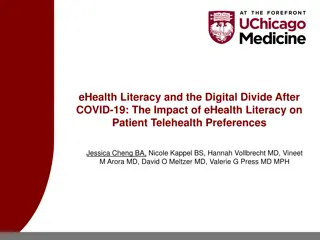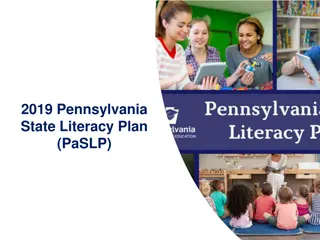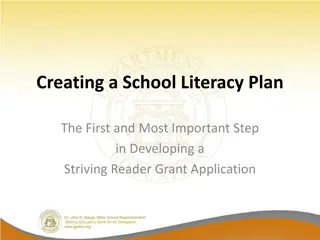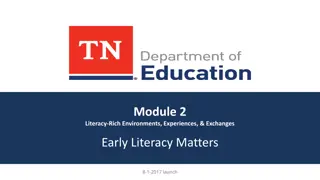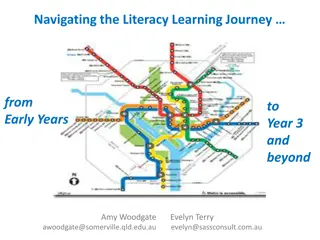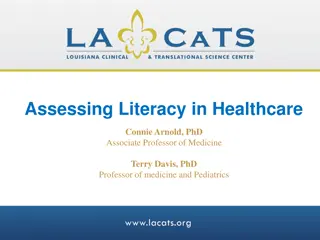Implementing Statistical Literacy at University of New Mexico: A Case Study
The case study delves into the challenges and processes involved in implementing a statistical literacy course, Math 1300, at the University of New Mexico (UNM). Dr. Milo Schield, supported by Dr. Eric Erhardt and Dean Peceny, undertook the task of creating a new course to complement the existing Math 1350. The approval process, including satisfying university and state curriculum requirements, is detailed along with course components like the Literacy Forum. The slides provide insights into the meticulous steps taken to introduce statistical literacy within the educational framework at UNM.
Download Presentation

Please find below an Image/Link to download the presentation.
The content on the website is provided AS IS for your information and personal use only. It may not be sold, licensed, or shared on other websites without obtaining consent from the author.If you encounter any issues during the download, it is possible that the publisher has removed the file from their server.
You are allowed to download the files provided on this website for personal or commercial use, subject to the condition that they are used lawfully. All files are the property of their respective owners.
The content on the website is provided AS IS for your information and personal use only. It may not be sold, licensed, or shared on other websites without obtaining consent from the author.
E N D
Presentation Transcript
V1 1 20216 Schield USCOTS Slides3 Teaching Confounding: Part 3: UNM and Cornfield Milo Schield, Augsburg University Fellow: American Statistical Association Member: International Statistical Institute US Rep: International Statistical Literacy Project President National Numeracy Network USCOTS Workshop Online June 26, 2021 www.StatLit.org/pdf/2021-Schield-USCOTS-Slides3.pdf
V1 2 20216 Schield USCOTS Slides3 Reason #6: Can t field a second course Lack of sections (FTE limit) University of New Mexico (Albuquerque) is offering MATH 1300: Statistical Literacy. UNM is using sections normally allocated to the traditional statistical inference course: MATH 1350 Introductory Statistics.
V1 3 20216 Schield USCOTS Slides3 Univ. of New Mexico 1. Math 1350 Introductory statistical inference. UNM offers ~20 sections (35 max) in ABQ. 2. Dr. Eric Erhardt (above left) looked for an updated complement to Math 1350. 3. Dean Peceny (above right) provided funds. 4. After interviewing several candidates, the committee choose Schield to implement his statistical literacy course.
V1 4 20216 Schield USCOTS Slides3 Getting Course Approved Getting a new course approved at a large public university is not a simple matter. Dr. Erhardt supervised the process. This new statistical literacy course needed to satisfy a mathematics requirement: in the university core curriculum. in the state higher-education general education curriculum.
V1 5 20216 Schield USCOTS Slides3 Getting Course Approved Registrar: 1. New course request (Form B) 2. Catalog description 3. Sample syllabus University of New Mexico (ABQ) 1. New course signoff 2. Budgetary load implications
V1 6 20216 Schield USCOTS Slides3 Getting Course Approved New Mexico Higher Education Department 1. Add Common Course Number (CCN) 2. Student Learning Outcomes (SLOs) NM Higher Education General Education 1. Add a course to Gen Ed curriculum 2. Goals and Student Learning Outcomes 3. Assess Student Learning Outcomes 4. Sample Assessment
V1 7 20216 Schield USCOTS Slides3 UNM 2021-22 Catalog .
V1 8 20216 Schield USCOTS Slides3 Course Component #1: Literacy Forum; 20% of grade Online forum (Odyssey). Two challenges per week. Write a short response No free riders and anonymous Grading by instructor and peers Odyssey: A Journey to Life-Long Statistical Literacy www.statlit.org/pdf/2014-Schield-ICOTS.pdf
V1 9 20216 Schield USCOTS Slides3 Course Component #2: Moodle Exercises: 30% of grade Multiple choice exercises 8 12 exercises per chapter. One topic per exercise; 5-10 questions each. Two tries (if more than 2 choices) Immediate feedback One-line essay exercises: Describe and compare counts, averages and percentages presented in tables and graphs.
V1 10 20216 Schield USCOTS Slides3 Course Component #3: Confounder StatLit Textbook 1: Statistical literacy: Take CARE 2: Comparisons and CARE remedies 3: Measurements and Standardization 4: Percent and Percentage Grammar 5: Rate and Chance Grammar. Social statistics 6: Comparisons Using Likely Grammar 7: Difficult Ratios and Cornfield Conditions 8: Influences on Statistical Significance
V1 11 20216 Schield USCOTS Slides3 Course Component #4: Quizzes and Final: 50% of grade Two, three or four chapter quizzes Chapters 1 and 2 Chapters 3 and 4 Chapters 4, 5 and 6 Chapters 7 and 8 Final: Comprehensive Read data in government documents.
V1 12 20216 Schield USCOTS Slides3 Teacher Training A New Prep!!! Less than a 30% overlap between confounder- based StatLit and traditional intro. Statistics. Recommendations: 1. Study Schield papers and StatLit textbook. 2. Introduce in last weeks of inference course. 3. Read articles in the everyday media 4. Analyze news stories in class. 5. Teach as a topics course
V1 13 20216 Schield USCOTS Slides3 Problem #6 Statistical Cynics Student: You convinced me: Never trust a statistic! Even if it is not influenced by assembly, randomness, error or bias, it could be confounded! Confounding can affect statistical significance. Our goal is not to create statistical cynics. Our goal is to help students be critical thinkers! How can we do this?
V1 14 20216 Schield USCOTS Slides3 Association between smoking and lung cancer deaths (1960) .
V1 15 20216 Schield USCOTS Slides3 Does smoking cause cancer? Sir Ronald Fisher (1950s): Fisher was pre-eminent statistician of that time! He noted that association is not causation! Fisher, a smoker, provided data showing a correlation between twinship (fraternal vs. identical) and smoking preference. Fisher s data supported the claim that genetics could be a cause of smoking and lung cancer. Who would think of confronting Fisher?
V1 16 20216 Schield USCOTS Slides3 Cornfield Conditions Jerome Cornfield There is no test for confounding! Cornfield proved a necessary condition for a confounder to nullify an observed association. Cornfield's minimum effect size is as important to observational studies as is the use of random assignment to experimental studies. Schield (1999) Simpson s Paradox & the Cornfield Conditions www.statlit.org/pdf/1999SchieldASA.pdf
V1 17 20216 Schield USCOTS Slides3 Three Greatest Contributions of Statistics to Human Knowledge 1. Standard error: Error expected in random samples between parameter and statistic. 2. Random assignment: statistically controls pre-existing confounders. Fisher (1930) 3. Cornfield conditions: Conditions necessary for a confounder to nullify or reverse an observed association. Cornfield (1958)
ASA TC 2013 18 Patient Condition: Good versus Poor * 1.6 pts more likely to die at City (5.5) than Rural (4.2) Good condition: walked in. Poor condition: carried in. * 3.7 pts more likely to die if Poor (6.25) than Good (2.75) 3.7 points > 1.6 points. So Cornfield #1 is satisfied.
V1 19 20216 Schield USCOTS Slides3 Cornfield Condition for Nullification or Reversal An association is nullified or reversed only if confounder (patient condition) has a stronger association with the outcome (death) than does the predictor (hospital). predictor (hospital) has a stronger association with the confounder (patient condition) than with the outcome (death).
V1 20 20216 Schield USCOTS Slides3 Cornfield Condition for Nullification or Reversal Condition: bigger death separation than Hospital. So Hospital-Death association could be reversed.
V1 21 20216 Schield USCOTS Slides3 How does Confounding Interact with Statistical Significance? Statistical educators know that a statistically- significant difference in observational data can become statistically insignificant after controlling for a related factor. But our students never see this. This is statistical negligence! Here is how it is shown in statistical literacy.
V1 22 20216 Schield USCOTS Slides3 Confounder Influence: Non-Overlap = Statistical Significance .
V1 23 20216 Schield USCOTS Slides3 Confounder Influence on Statistical Significance .
V1 24 20216 Schield USCOTS Slides3 Meaning of Statistically Significant If a sample outcome is statistically significant, what does this mean? 1. Outcome is very unlikely IF* due to chance 2. Outcome is very unlikely due to chance 3. Outcome is very unlikely TO BE due to chance #1 is accurate (* given or assuming) #3 is wrong: opens the door to causation. #2 is in-between and ambiguous.
V1 25 20216 Schield USCOTS Slides3 Why We Should Teach Statistical Literacy 1. Most students need it, see value in it. 2. Separating stats from math has benefits 3. Link statistics to critical thinking (rhetoric) 4. Can show influence of confounding, assembly and bias on statistical significance 5. Can show the story behind the statistics 6. Cornfield conditions offset cynicism 7. Can improve debate on social issues
V1 26 20216 Schield USCOTS Slides3 Schield Resources Read papers: www.StatLit.org/Schield-Pubs.htm Buy textbook: Wiley to publish in 2022.






